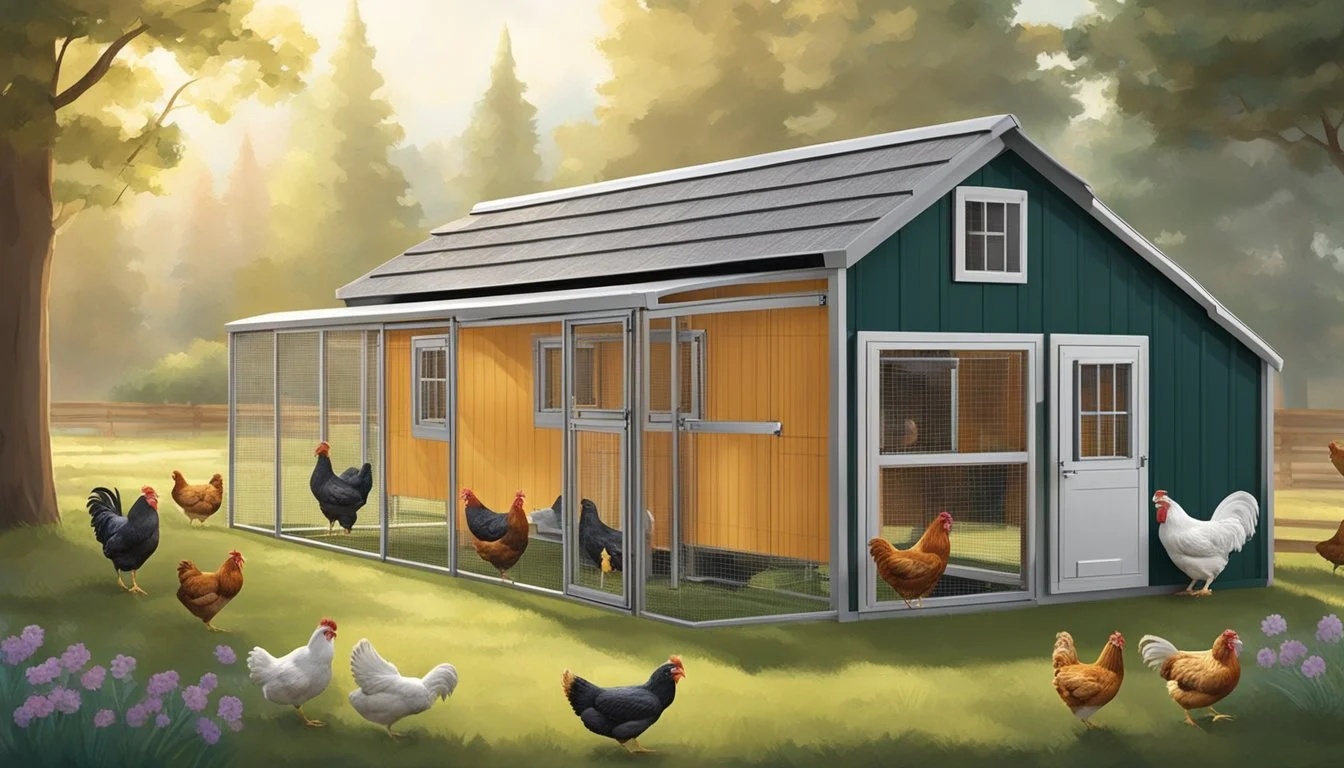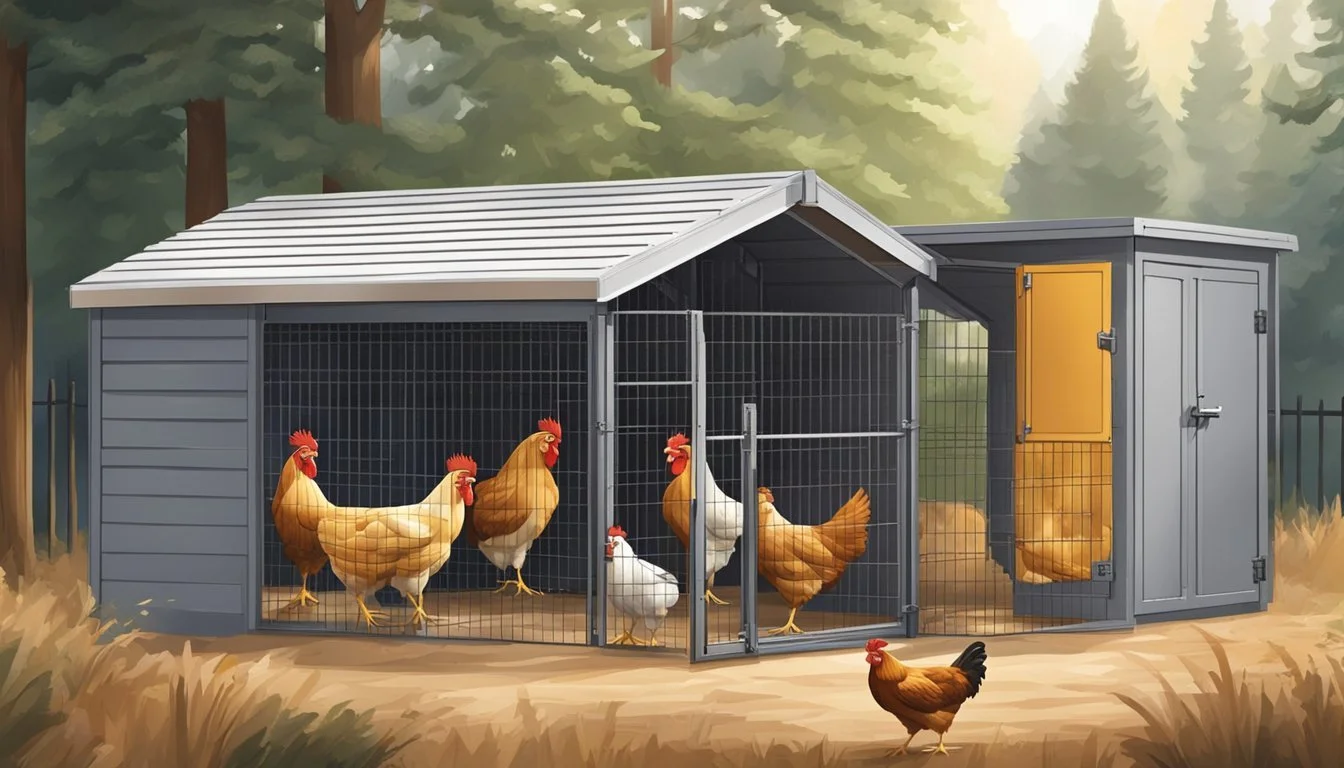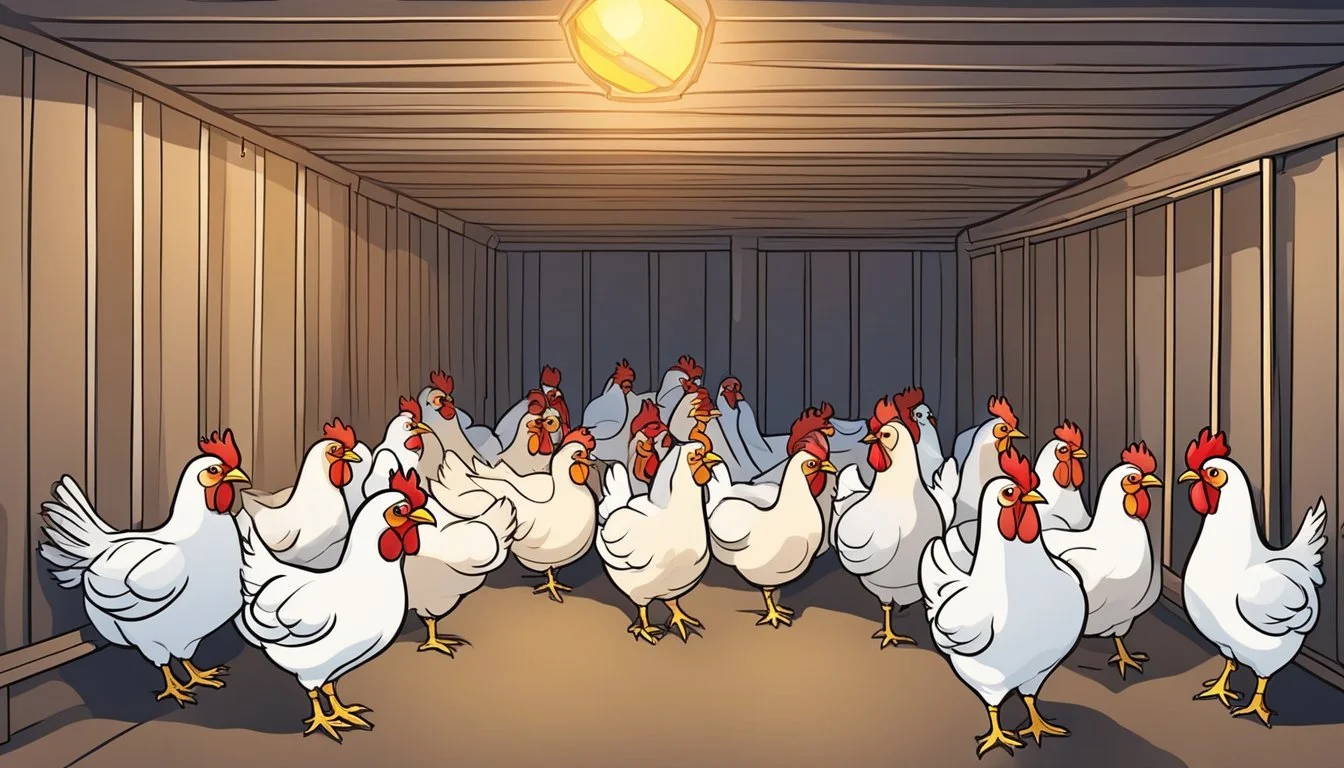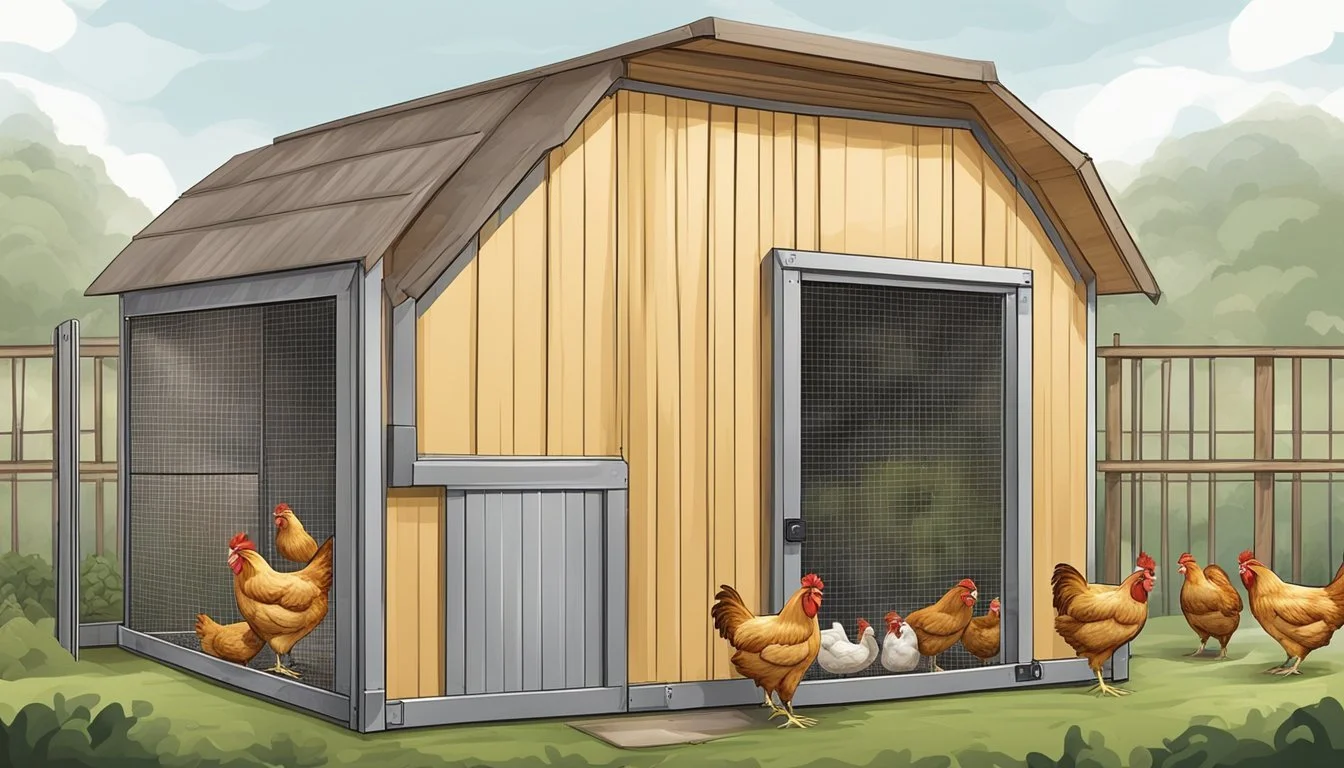How do I Prepare My Chickens for Extreme Weather Conditions?
Essential Protection Strategies
Extreme weather conditions present various challenges for chicken keepers, from blistering heatwaves to freezing blizzards. Ensuring the well-being of their flock requires preparation, adaptation, and understanding of the impacts of severe weather. Chickens are hardy animals, but they rely on their owners to provide shelter, food, and water that can withstand environmental extremes.
Owners must be proactive in modifying chicken coops and runs to safeguard their birds. In areas prone to heavy rain and flooding, for instance, securing the coop on high ground prevents water from seeping in and causing potential health issues for the chickens. Preparing for cold snaps involves checking the coop for drafts, insulating it where necessary, and making sure that there is sufficient ventilation to maintain a dry environment, avoiding humidity that can lead to frostbite.
As temperatures plunge, it's important to understand the signs of cold stress in poultry and the measures needed to protect them. Providing additional food, for example, can help chickens generate more body heat, while strategies to prevent frostbite on combs and wattles are critical during winter months. On the hottest days, ensuring continuous access to water and shade becomes paramount in preventing heat stress. By preparing their coops for these conditions, owners can help ensure that their chickens stay healthy and productive no matter what the weather brings.
Understanding Chickens' Needs in Extreme Weather
Chickens are resilient birds, but extreme cold can significantly test their limits. Preparing for harsh conditions ensures that chickens remain comfortable and healthy. Chickens naturally maintain their body heat by fluffing up their feathers, which traps warm air close to their bodies. In a cold climate, their ability to generate enough heat to stay warm can be compromised.
Key considerations for chicken welfare in extreme weather include:
Insulation: Just as insulation keeps a home warm, a well-insulated coop can help chickens retain body heat. The coop should be free of drafts and moisture, which can decrease the insulating properties of feathers.
Ventilation: Good air quality is essential to prevent respiratory problems, yet it must be balanced to avoid cold drafts. Vents should be placed high to allow moisture to escape without creating a direct path for wind.
Roosting: Chickens will roost together to share body heat. Ensuring the roost bars are of appropriate size and height allows them to huddle and lift their feet away from cold surfaces.
Access to Water: Chickens need access to liquid water, even in freezing conditions. Water sources may need to be heated to prevent freezing.
Diet: Providing a diet high in energy can help chickens generate more body heat during extreme cold. Extra grains and feed can provide this energy.
Health Checks: Monitoring the flock's health is important. Any signs of discomfort or illness require prompt attention.
Implementing appropriate measures based on an understanding of chickens' physiological needs and behaviors in cold weather is crucial for their well-being.
Coop Insulation and Management
Proper insulation and management of a chicken coop are crucial for protecting poultry from extreme weather conditions. This involves carefully evaluating and improving the structure to ensure chickens remain safe and comfortable.
Evaluating Coop Insulation
The success of coop insulation starts with a thorough assessment. It’s essential to examine the coop's walls and ceiling for any areas where heat might escape. High-quality insulation materials can shield chickens from the cold and prevent heat from entering during warmer months. Insulation must be secure and free of gaps to be effective.
Implementing Draft Protection
Drafts can be detrimental to chicken health, allowing cold air to enter the coop and cause temperature fluctuations. Sealing any holes and cracks prevents unwanted drafts. However, adequate ventilation is still necessary to remove moisture and ammonia, which suggests strategically placed vents or openings that can be protected with wire mesh to maintain airflow without letting cold air sweep through the coop.
Maximizing Bedding Efficiency
Bedding serves as an additional layer of insulation and aids in moisture control. Materials like straw or shavings can be spread evenly to create a thick layer on the floor of the coop. The deep litter method, where bedding and manure are allowed to accumulate and compost over time, generates heat and can be particularly useful in colder climates. Consistently adding fresh bedding atop the old layer insulates the floor and contributes to a warmer environment.
Coop Cleaning and Maintenance
Regular cleaning is fundamental for coop maintenance, especially before extreme weather hits. This should include the removal of old bedding, manure, and debris. A deep clean that involves scrubbing surfaces and allowing them to dry reduces the risk of disease and pest infestations. Post-cleaning, replenish the coop with fresh bedding to ensure the chickens have a clean, insulated, and comfortable space to endure harsh weather conditions.
Temperature Control Solutions
To ensure the health and comfort of chickens during extreme weather, it's essential to implement robust temperature control solutions. Strategically used heat sources and the proper installation of water heaters can make a significant difference.
Choosing and Using Heat Lamps
Heat lamps are a popular choice for keeping chickens warm. When selecting a heat lamp, it is crucial to choose one that is appropriate for the size of the coop to avoid overheating. Securely mount the heat lamp to reduce fire risk, and ensure that the chickens cannot come into contact with it. It's recommended to have a lamp that emits red light, as it is less disruptive to the chickens and promotes a calming environment.
Harnessing Radiant Heaters
Radiant heaters provide a safer alternative to heat lamps, as they reduce fire hazards and offer more uniform heat distribution. They work by emitting infrared rays that warm the chickens directly. Make sure the radiant heater is installed at an appropriate height, and always follow the manufacturer's recommendations for use and safety precautions.
Water Heater Installation
A water heater is essential to keep the water supply from freezing, which ensures chickens have access to liquid water at all times. Install a thermostatically controlled water heater that activates at low temperatures. Some key considerations are:
Size & Capacity: Match the water heater's capacity to the flock's size.
Insulation: Ensure adequate insulation around the water pipes to prevent freezing.
Placement: Place the water heater in a spot where chickens cannot tip it over or get burned.
By incorporating these solutions, one can maintain a stable and comfortable environment for chickens during extreme weather conditions, whether hot or cold.
Water and Feeding Strategies
Ensuring that poultry has access to unfrozen water and proper nutrition is vital in extreme weather conditions. Poultry keepers must adjust water and feeding strategies to maintain their flock's health and productivity.
Preventing Frozen Water
In cold weather, water can easily freeze, making it inaccessible to chickens. A heated waterer is an effective tool to prevent water from freezing. Alternatively, floating a few ping pong balls in the water can slow down the freezing process as chickens peck at them. Including a splash of vinegar in the water can also reduce freezing while keeping water containers clean.
Selecting the Right Feed and Supplements
Chickens require higher-energy feed during colder months to help maintain their body temperature and health. It's recommended to increase grain intake, particularly corn which can help generate more body heat. Additionally, protein supplementation is crucial for sustaining feather growth, essential for insulation. Poultry owners should ensure a balanced diet that meets all the nutritional needs of their chickens.
Safe Feeder and Waterer Placement
Feeders and waterers must be located in areas that discourage dampness and frostbite while remaining accessible. Placing feeders and waterers under shelter can protect them from the elements. They should be positioned off the ground to prevent contamination and should be sturdy enough to avoid tipping and spilling, ensuring that chickens always have access to food and water.
Protecting Against Weather-Related Health Issues
Extreme weather can pose significant health risks to chickens, with issues like frostbite being a primary concern during cold conditions. Precautions are focused on recognizing signs of frostbite and providing care to sensitive areas such as the comb and wattles.
Recognizing Frostbite Signs
Chickens are vulnerable to frostbite, particularly on their combs and wattles. Indicators of frostbitten areas include discoloration, which appears as pale, white, or even blackened tips. They may also exhibit signs of discomfort or reluctance to eat if their wattles are affected. Early detection is crucial to prevent permanent damage.
Comb and Wattle Care
Providing protection against frostbite involves practical steps to safeguard the chicken's comb and wattles. One effective method is the application of a thin layer of petroleum jelly on these areas, which adds a barrier against moisture and cold. It's essential to ensure that the living environment is well-ventilated yet free of drafts, as stagnant moist air can exacerbate the risk of frostbite.
Enhancing Coop Security
To ensure the safety of chickens during extreme weather, reinforcing the coop against predators and conducting regular inspections are critical steps. These measures keep the shelter secure and maintain a safe environment.
Reinforcement Against Predators
Predators are a constant threat, particularly during severe weather when other food sources might be scarce. Reinforcing the coop is paramount. One should upgrade locks and latches on doors to be predator-proof, as simple closures might not suffice. Hardware cloth is a stronger alternative to chicken wire; it's advisable to cover windows and runs with it to prevent any unwelcome entry.
Regular Inspection for Weak Points
A routine inspection for weak points can significantly enhance the coop's resilience. One should systematically check for cracks and holes in the coop's structure. Small openings not only invite predators but also allow harsh weather to enter. It is essential to fix any found breaches immediately. Moreover, doors and hinges should be regularly inspected to ensure they are intact and function properly, as harsh weather can cause unexpected damage.
Preparation for Specific Climatic Regions
Properly preparing chickens for extreme weather conditions depends greatly on the regional climate. Cold climates demand unique approaches, while the Midwestern winters have their own set of challenges.
Considerations for Cold Climates
In cold climates, chickens require additional protection to maintain their body heat and prevent frostbite. Insulating the coop effectively is paramount. The coop should be free of drafts while providing adequate ventilation to avoid moisture build-up. It's essential to ensure that the chickens have access to unfrozen water at all times. Owners might consider heated waterers to prevent freezing. Adding more bedding material, such as straw or wood shavings, helps to conserve heat. Information on managing chickens during cold stress can be found at Caring for chickens in cold weather.
Insulation: Proper insulation without eliminating ventilation
Water: Use of heated waterers to keep water from freezing
Bedding: Increased bedding material for heat conservation
Adaptations for Midwestern Winters
Chickens in the Midwest face winters that can be harsh with varying periods of extreme cold and wind. Coop preparation in the Midwest includes reinforcing against wind while avoiding moisture accumulation that could lead to frostbite. Providing a windbreak, such as a solid wall or dense vegetation outside, can shield the coop from prevailing winds. It's also critical to monitor the condition of the birds' combs and wattles for signs of frostbite, treating affected areas with care. For more tips on maintaining chickens' health during the frigid months, visit How to Prepare Chickens for Winter.
Windbreaks: Installation of windbreaks to protect from harsh winds
Monitoring: Regular health checks, particularly of combs and wattles
Treatment: Gentle application of petroleum jelly as a frostbite preventative measure
Seasonal Considerations for Hens and Egg Laying
When preparing for extreme seasonal conditions, ensuring steady egg production and the health of your hens are paramount. It's crucial to take proactive steps to adapt the environment and care routines to maintain output and hen welfare.
Maintaining Egg Production
To preserve egg production during colder months, farmers typically adjust lighting in the coop. Hens require about 14-16 hours of light per day for optimal laying. Installing timed artificial lights can mitigate the shorter days of winter, encouraging the hens to continue producing eggs.
Temperature fluctuations can impact laying patterns. Maintaining a consistent coop temperature is key to prevent a drop in egg production. Insulation and the prevention of drafts can help keep hens comfortable. In addition, ensure nesting boxes are kept clean, as dirty or wet conditions can lead to egg rot and a decline in laying.
Caring for Hens in Extreme Cold
The average body temperature of a chicken is around 106 degrees Fahrenheit, and they can experience cold stress in low environmental temperatures. Preventative measures include reinforcing the coop against the elements; adding extra bedding for insulation can be particularly effective.
Implementing windbreaks like plastic sheeting over exposed areas of the coop prevents drafts while allowing for necessary ventilation. It's also important to manage the moisture levels in the coop to avoid frostbite. Keep a vigilant eye on your hens' combs and wattles, as these are indicators of how well they are coping with the cold. Providing a high-energy diet can also help hens maintain their body temperature during extremely cold weather.
Feeding Adjustments in Winter
During the colder months, chickens require extra energy to maintain their body heat and stay healthy. Therefore, owners should adjust their chickens' diet to meet these increased energy demands.
Corn: Introducing more corn into the chickens' diet is beneficial in winter, as it is a good source of carbohydrates that helps generate body heat during digestion. An evening snack of corn can keep the birds warmer through the night.
Protein: It is paramount to maintain a diet high in protein, because chickens need it for continued egg production and feather regrowth, which often occurs in preparation for the winter. High-protein feeds and supplements should be consistently provided.
Oatmeal: A warm morning serving of oatmeal can be a comforting treat for chickens in winter. Oatmeal is not only warming, it also provides essential nutrients and can help diversify their diet.
Essential Nutrients: Carbohydrates
Sources: Corn, Oatmeal
Essential Nutrients: Protein
Sources: Layer feeds, Mealworms
Adding a bit of extra scratch grain in the late afternoon can assist hens in keeping warm overnight. Caution should be taken as too much grain can lead to obesity; moderation is key.
Lastly, owners must ensure that chickens have access to unfrozen water at all times, as dehydration can become an issue in winter. A chicken's feed intake might increase during cold weather, so observe and adjust the feeding quantities as needed.
Additional Coop Enhancements
To ensure your chickens remain comfortable during extreme weather conditions, focus on coop enhancements that optimize airflow and retain warmth. These specific adjustments provide an environment tailored for weather resilience.
Improving Airflow and Humidity
Maintaining proper airflow is crucial in a chicken coop to manage humidity levels and prevent respiratory issues in chickens. Consider installing vents strategically placed at both the high and low points of the coop. This creates a cross ventilation system that allows fresh air to enter and stale, humid air to escape. However, be sure these vents have secure covers that can prevent predator intrusion and can be closed during severe storms. Additionally, for areas with high humidity, integrating a hygrometer to monitor the levels can guide when to increase or decrease ventilation.
Utilizing Coop Additions for Warmth
To address cold weather and keep the coop warm, insulation is key. Insulating the ceiling is particularly effective as it traps heat rising from the chickens themselves. Insulation options include foam boards, reflective materials, or fiberglass batts—each with its own benefits regarding warmth retention and ease of installation. Moreover, adding a thick layer of bedding such as straw or pine shavings can provide additional warmth and comfort. For those extremely cold climates, coop heaters or heat lamps can be installed, but it's important to use these devices with caution to avoid fire hazards.
Selecting Chicken Breeds for Weather Resilience
When preparing chickens for extreme weather, selecting the right breeds is crucial for resilience. These breeds should be able to maintain health and productivity despite fluctuations in temperature and humidity.
Choosing Hardy Breeds
Cold Climates:
Brahmas: This breed is known for its large size and feathered feet, making it well-suited for cold weather. Their thick plumage provides excellent insulation. They’re also known for their calm temperament, which can be beneficial for hobby farmers looking to maintain a peaceful coop environment.
Wyandottes: These chickens have a rose comb and a dense feather pattern, features that reduce the risk of frostbite and help retain heat. They are reliable layers through winter, making them a practical choice for those looking to keep a productive flock.
Hot Climates:
Leghorns: Recognized for their heat tolerance, Leghorns have a high rate of egg production even in warmer weather. Their lighter weight and less dense feathering help keep them cool.
Anconas: These birds are adept at staying cool due to their Mediterranean origins. Anconas are active foragers and egg layers, which can be a safe bet for hobbyists in warmer regions looking to sustain egg production.
Dual-Purpose Breeds:
Plymouth Rocks: A hardy, docile breed that performs well in various climates. They are also dual-purpose, suitable for both egg laying and meat production.
Selecting chicken breeds that naturally thrive in your region's climate can ensure the safety and well-being of your flock.
Adapting Breeds to Varied Climates
Gradual Acclimatization: Allowing chickens to naturally acclimate to changing temperatures over time can increase their hardiness. Starting with chickens that have a baseline resilience to weather extremes provides a foundation upon which they can adjust to slight climate variations.
Shelter Modifications: Providing shelter that is adaptable to changing weather conditions can help chickens maintain their normal body temperature. Strategic use of insulation, ventilation, and protective barriers can assist in modifying an existing breed's capacity to withstand unusual weather patterns.
By considering the specific climate needs of various chicken breeds and implementing adjustments to their environment, farmers can create a safe and productive habitat for their poultry.
Engaging in Community and Expert Resources
When preparing chickens for extreme weather conditions, poultry keepers should leverage community and expert resources for best practices. Online forums and local farming groups often serve as valuable platforms where individuals can share experiences and offer advice.
Local Extension Offices: They typically offer resources on a wide range of agricultural topics, including poultry care. Poultry keepers can benefit from their guidelines on weather preparation and management.
Workshops
Pamphlets
Direct consultations
Veterinarians Specializing in Poultry: These experts provide insights on maintaining chicken health during stress caused by severe weather. They can also recommend measures to strengthen coop structures and improve emergency response readiness.
Online Communities:
Dedicated to poultry hobbyists.
Provide a space to discuss and learn from others’ experiences.
Often include contributions from experts in the field.
Resource Type: Online Forums
Benefits: Immediate peer support
Resource Type: Workshops
Benefits: Hands-on learning experience
Resource Type: Expert Consult
Benefits: Professional, tailored advice
Poultry keepers should be proactive in engaging with these resources well before severe weather strikes. By doing so, they can ensure their chickens are better protected, and their response to emergency situations is swift and effective.
Checklist for Weather Preparedness
When preparing chickens for extreme weather, there are several key steps to ensure their safety and well-being. A confident and clear approach is vital to tackle severe weather threats effectively.
Inspect the Coop:
Verify structural integrity; repairs are critical prior to any storm.
Ensure the coop and run are free from objects that could become flying debris.
Check for leak points and secure weather-proofing measures.
Feed and Water Supplies:
Stockpile enough feed in a dry, secure place.
Have a plan for maintaining water supply, even in freezing conditions.
Secure feeders and waterers; they should be heavy or anchored to resist strong winds.
Shelter and Warmth:
Provide ample straw or bedding to retain heat.
Consider installing a safe heating element if extreme cold is anticipated.
Create windbreaks outside to reduce chill.
Emergency Plan:
Establish a procedure for quick coop access during a storm.
Have a first aid kit and emergency supplies ready.
Maintain a list of contacts for veterinary or weather-related emergencies.
Regular Maintenance:
Regularly trim back trees and branches near the coop to prevent damage.
Consistently prepare your chicken coop for changing seasons to mitigate risks.
By following these steps, one can feel confident that their chickens are well prepared for extreme weather. Regular checks and maintenance are instrumental in reducing risk and ensuring the safety of the flock.






